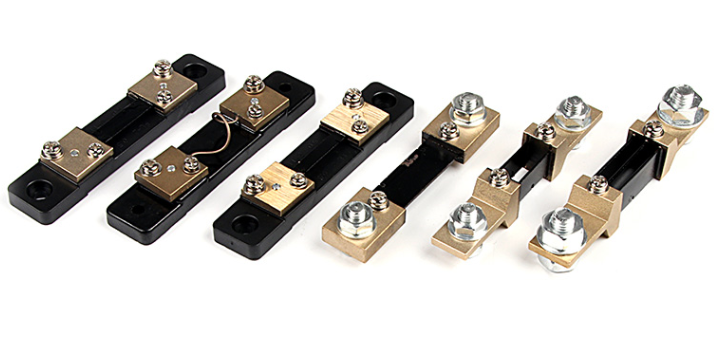Position:Home » Industry News
Shunt Resistor's Feature and Usage
Writer:Microhm Page View:Date:2019-07-08
An ammeter shunt allows the measurement of current values too large to be directly measured by a particular ammeter. In this case, a separate shunt, a resistor of very low but accurately known resistance, is placed in parallel with a voltmeter, so that all of the current to be measured will flow through the shunt. The resistance is chosen so that the resultant voltage drop is measurable, but low enough not to disrupt the circuit. The voltage across the shunt is proportional to the current flowing through it, and so the measured voltage can be scaled to directly display the current value. Shunts are rated by maximum current, and voltage drop at that current. For example, a 500 A, 75 mV shunt would have a resistance of 150 microohm, a maximum allowable current of 500 amps and at that current the voltage drop would be 75 millivolts.

Precision Shunt Resistors are characterized by low temperature co-efficient, high stability of electrical resistance, low watt loss, and good heat dissipation. Furthermore, since mounting generally involves contact with copper, the copper welded to each side facilitates the mounting without the problems of thermo EF and galvanic action.

Electron Beam Welded SHUNT manufactured by Microhm using copper, MnCu or NiCr alloy strips forms an integral part of "Battery Management System" (BMS) or "Intelligent Battery Sensor" (IBS) for vehicles as well as "Electronic Energy Meter.” We have an integrated manufacturing capability from designing stage to bulk supplies.

Precision Shunt Resistors are characterized by low temperature co-efficient, high stability of electrical resistance, low watt loss, and good heat dissipation. Furthermore, since mounting generally involves contact with copper, the copper welded to each side facilitates the mounting without the problems of thermo EF and galvanic action.

Electron Beam Welded SHUNT manufactured by Microhm using copper, MnCu or NiCr alloy strips forms an integral part of "Battery Management System" (BMS) or "Intelligent Battery Sensor" (IBS) for vehicles as well as "Electronic Energy Meter.” We have an integrated manufacturing capability from designing stage to bulk supplies.
Keywords:Shunt Resist
Latest News
- Resistor's role in measuring and correcting LED,,,
- Single through-hole resistors' characteristics ,,,
- Why shunt resistors for current sense applicati,,,
- Metal-film resistors with small size, high resi,,,
- 36W High-Current Shunt Resistors MMS8420,,,
- 1W Surface Mount Resistor MPR1206,,,
- An Overview of Microhm Electronics' Resistor Pr,,,
- More anti-sulfur resistors used in harsh envir,,,
- Resistance changes with temperature,,,
- 140W TO247 High Power Heatsinkable Resistor,,,
- MMS5930 is ideal for current sensing in industr,,,
- Shunt resistors selection for engineers' design,,,
- Considerations for choosing precision resistors,,,
- Ceramic Encased Cement Resistors NWH Series for,,,
- Resistors for Passive Balancing in Battery-Pow,,,
Hot Articles
- Microhm will take part in 10th Automotive World,,,
- Thanks for Visiting Microhm's Booth E5-5706 in ,,,
- Resistors in Short Supply: Blame Cars,,,
- New lunch: High Power Precision Shunt Resistor,,,,
- How to Test a Resistor,,,
- Innovative Technology, Future Electric: Electri,,,
- What is Precision Resistors?,,,
- SMD Resistors Sizes and Packages,,,
- The Construction and Features of Metal Film Res,,,
- What is a TO-220 Resisor?,,,
- Hot Selling Products: Precision Shunt Resistors,,,
- How to Calculate the Equivalent Resistance Valu,,,
- What is a Fixed Resistor?,,,
- Resistors in LED Circuits,,,
- Resistors Types and Materials Overview,,,
Resistance applications
- Why Zero-Ohm Resistors?,,,
- Heater Blower Motor Resistor in Air Conditioner,,,
- The Main Application for High Precision and Low,,,
- Miniature future for passive electronic compone,,,
- Surface Mount Resistor's Size and Package ,,,
- BMS for New Energy Vehicle,,,
- Shunt Resistor MMS8420 for High Current Stable ,,,
- Precision Resistors' Construction and TCR,,,
- The Four Important Functions of Alloy Resistors,,,
- Difference Between High Precision Resistors and,,,
- Carbon Film Resistors' Features and Application,,,
- The Measurement Accuracy of Automotive Shunt is,,,
- Urbanization Development Bringing the Transform,,,
- Select the Right Resistor for Harmonic Filterin,,,
- Industrial Roberts Applied to Solar Photovoltai,,,
